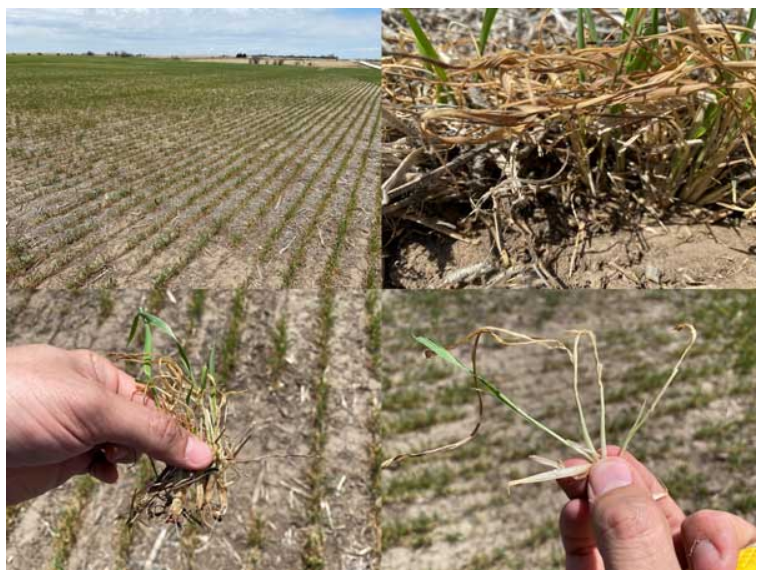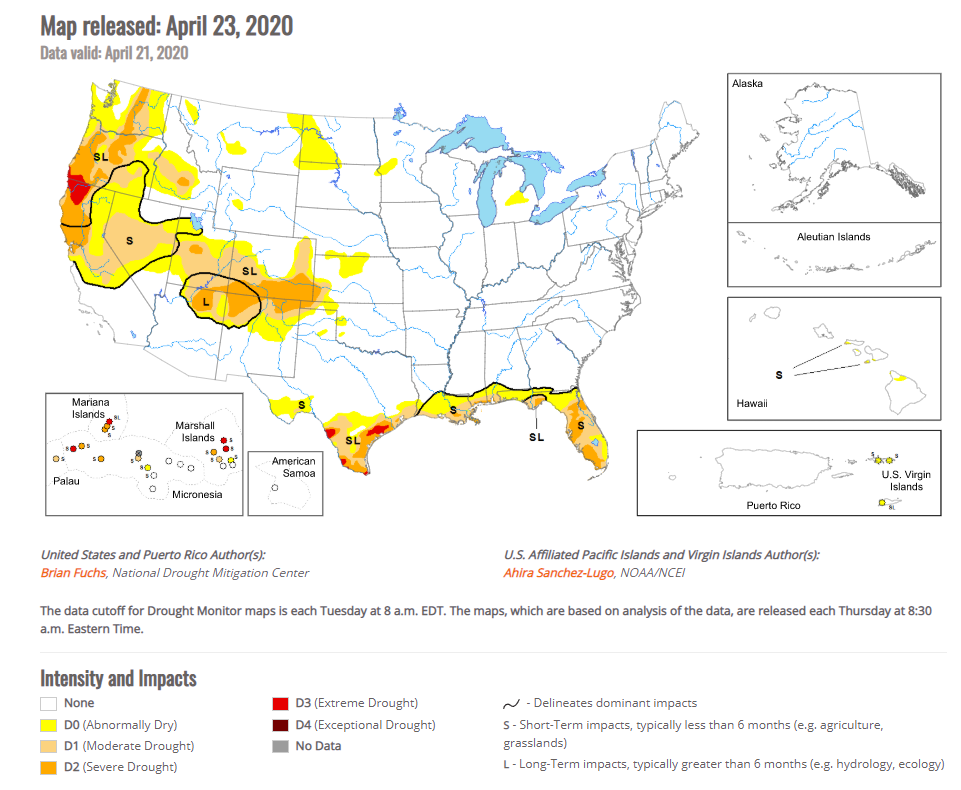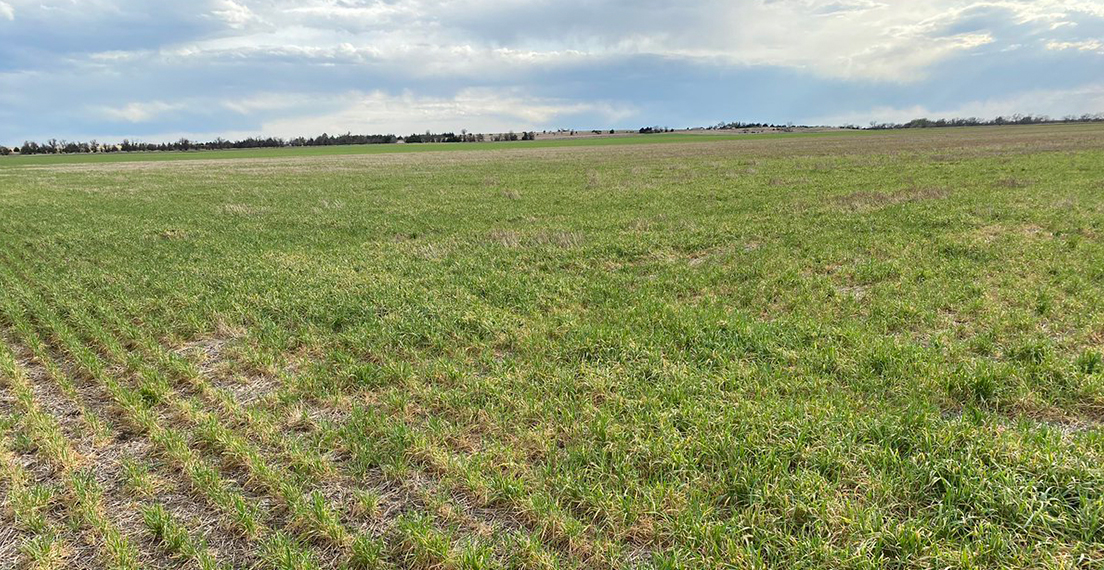Dry Weather and Freezing Temperatures Challenge Hard Red Winter Wheat Crop
By Claire Hutchins, USW Market Analyst
The condition of the U.S. hard red winter (HRW) wheat crop is not improving. Farmers – and the markets – are concerned about the threats to yield potential from wide-spread April freezes and increasing dryness across a significant portion of the Central and Southern Great Plains.
USDA’s most recent crop condition ratings reflect the weather effects on the 2020-21 winter wheat crop, reducing the total crop rated good to excellent from 62 percent to 57 percent. According to Romulo Lollato, Kansas State University Wheat and Forages Specialist, drought weakens winter wheat’s ability to recover from freeze damage and both conditions challenge winter wheat yield potential. So the change in ratings is focused on the HRW crop, based on the worsening dryness in north central and southwestern Kansas, eastern Colorado and south central Nebraska. And this week, the extent of freeze damage is being monitored carefully in the following states.
Kansas. Between April 20 and April 27, USDA reduced its Kansas winter wheat rating from 46 good to excellent to 40 percent as localized freezes and expanding dryness threaten crop progress.
“About 50 to 60 percent of the state’s wheat was impacted to varying degrees by freeze damage,” said Lollato. In north-central Kansas, several counties showed varying but considerable freeze damage. According to researchers at Kansas State University, the crop in that region needs moisture soon to help with freeze damage recovery. In parts of central Kansas, late-sown fields, following a soybean crop, showed severe leaf and tiller damage from recent freeze events. In parts of northwestern Kansas, dry soil conditions predisposed plants to freeze damage and in some cases severely damaged fields turned yellow and brown as plant tissue deteriorated. Southwest Kansas is still extremely dry and could impact the crop’s ability to recover from freeze damage. Looking ahead, hot, dry temperatures across the state could further challenge the crop’s ability to recover from freeze damage.

Late-sown fields in north central Kansas showed severe leaf and tiller damage from recent freeze events. Photos courtesy of Romulo Lollato.
Colorado. “Our story is dryness – we need rain,” said Brad Erker, Executive Director of the Colorado Wheat Administrative Committee.
Several weeks ago, USDA rated 54 percent of Colorado’s winter wheat in good to excellent condition. As of April 27, only 37 percent of the state’s crop is in top condition. Moderate to severe drought plagues the eastern third of the state, where the winter wheat is grown. There is little evidence yet that freeze damage has impacted the crop, but reports are still developing. Looking ahead, high temperatures and no moisture in eastern Colorado could continue to pressure the state’s yield potential.

The April 23 UNL Drought Monitor showed a significant expansion of abnormal dryness and severe drought across the Central and Southern Plains, with dry conditions expanding in North Dakota and the Pacific Northwest.
Nebraska. HRW conditions in Nebraska are better than in Kansas and Colorado, with 69 percent of the crop rated good to excellent. However, freezing temperatures impacted wheat across the state. According to Sarah Morton, Agriculture Promotion Coordinator for the Nebraska Wheat Board, temperatures close to 10 degrees Fahrenheit (-12 degrees Celsius) in Nebraska’s southern Panhandle “knocked the wheat back and turned it brown,” slowing growth. Freezing temperatures in southwest Nebraska also burned back the wheat. Adequate soil moisture levels and warmer temperatures in the western part of the state are expected to help the crop recover from recent freezes. On April 23, the University of Nebraska – Lincoln Drought Monitor introduced abnormal dryness into the south-central portion of the state.
Oklahoma. Reports from Oklahoma show significant freeze damage in some of the state’s southwest and south-central counties. Some counties in southwestern Oklahoma reported freeze damage across 40 to 70 percent of the crop. In several extreme cases, some areas in south-central Oklahoma showed freeze damage in virtually every field. The April 23 Drought Monitor expanded areas under abnormal dryness and severe drought in the Oklahoma Panhandle. As of April 27, 62 percent of the state’s HRW is in good to excellent condition, down from 65 percent the week before, with expectations that the condition will continue to deteriorate.
“It’s an extremely challenging time for southwestern Oklahoma producers,” said Mike Schulte, Executive Director of the Oklahoma Wheat Commission.
Header photo courtesy of Romulo Lollato.


